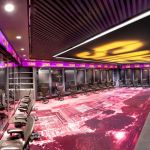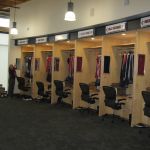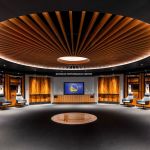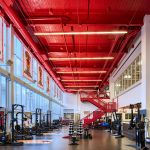
The aesthetics of the changing rooms
How one of the most sacred and intimate places in sport has changed over time
June 1st, 2020
In "The Last Dance" we had the opportunity to notice numerous aesthetic details of MJ - from glasses to hats, from his machines to the most disparate outfits - but also, more generally, from the NBA of the time: one of the aspects what struck us most was to note that from an ''architectural'' point of view the League did not give particular importance to one of the most popular environments for athletes: the locker room.
In fact, in the scenes in which Jordan and the Bulls are inside the various ''locker rooms'' you can easily see the qualitative difference between the bare and soulless environments of the past compared to the hyper-equipped ones of today that remember more privé of a disco, with large spaces where comfortable armchairs and giant screens have been placed. We are talking about environments that guard the secrets of teams and entire seasons and which until a few years ago were synonymous with intimacy and whose primary use was to change and, at best, to talk about pre-game tactics.
But over time, spaces and consequent dynamics have changed: now the private changing rooms have very little, they represent the place that arouses most curiosity within a '' stadium tour '', precisely because you want to see where your favorites they do the routine before they set foot on the pitch and where they spend time together. To give us a further taste of what is happening are the TV cameras that - at least in the Serie A football championship - now have access to the changing rooms until a few moments before the start of the game. In the NBA, the situation is even more extreme since, in addition to the pre-game, the broadcasters can also enter from 30 minutes after the end of a game in order to also catch any discontent among teammates.
And what you can see on TV are no longer empty spaces with a table, a blackboard and benches with some hangers, but we find real open spaces that lead to the "weight rooms", cryotherapy rooms or to the whirlpools.
The transformation of the changing room from a simple ''room'' to a ''community place'' is a process wanted by the clubs to make sure that the players can spend as much time together as possible, just to promote that series of activities that are in fact called team building . In the locker rooms of stadiums and palaces all over the world the goal is to create comfort and relaxation with the aim of increasing the desire to feel part of a large family where, in this case, the house is just the locker room.
A few months ago the news of Louisiana State University made headlines that for the renewal of the changing rooms of its football team spent 28 million dollars: inside extendable armchairs where you can sleep - called precisely ''nap room'' - also equipped iPads and USB chargers, a top-level training facility, a cinema, a swimming pool and a restaurant.
The LSU locker room is the most cutting-edge locker room in the world but it must always be remembered that a football team consists of about 50 (large) players and that the necessary spaces must be adequate, which is why it is certainly easier to find locker rooms huge and technological in this sport rather than in football where the squad is instead made up of ''only'' 25 players.
This does not mean that in recent years even the properties of the most popular sports teams in the world have worked to keep up with the times and - some more, some less - have renovated and / or modernized their changing rooms. There are those who have had the opportunity to build them from scratch together with the new stadium, such as Manchester City and Juventus and those who have been able to change the furniture and make some changes to increase appeal and rate of modernity without being able to touch the walls carriers.
This is the case of Liverpool, Barcelona and the two Milanese teams which, having stadiums dating back respectively to 1884, 1954 and 1926, cannot aspire to have the changing rooms of teams with more recent structures.
Slightly different discourse regarding the NBA where the teams are made up of 15 players and whose changing rooms, especially those in the ''training facility'', have always been sized in proportion to the size of the players. In the American League there are no prominent changing rooms because it is the NBA itself that provides basic standards to the companies within which you cannot go down in quality.
In this case the changing rooms of the Barclays Center in Brooklyn and the Chase Center of San Francisco, inaugurated in 2016 and 2019 respectively, are newer than the historic Staples Center in Los Angeles or Madison Square Garden in New York, but the players of each team have the same identical structures at their disposal, albeit with more or less recent finishes.
For many - if not all - having a slightly more comfortable chair or a shiny cabinet rather than an old one, it may not make a difference. But he did it instead for LeBron James who in summer 2009, just as he was discussing the renewal of his contract with the Cavaliers, asked the company to renew the locker room and some details of the building in order to increase the chances that another superstar got married in Cleveland. The franchise - of course - fulfilled LBJ's requests, but the only notable player who caught up with him was an old Shaquille O'Neal who didn't affect the Ohio team's performance that much.














































